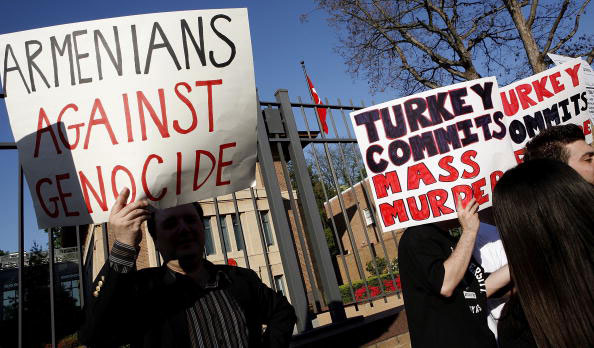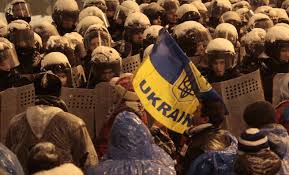By philosproject.org
Islamic jihad combined with Turkish supremacism not only turns once powerful, indigenous nations into virtual extinct communities, but also transforms the few survivors into remnants.
“We are hostages!” said an Armenian woman living in Istanbul, describing the relationship between the Armenian minority with the Turkish state and Turkish society. “Sure, they allow us to pray in our churches, and we are also allowed to pay for our schools, but that is all. They do what they please with us.”
The latest Turkish outburst of intolerance – apparently an attempt to satisfy the Turkish-Islamic sense of supremacism – was on display in the district of Tuzluca, an ancient Armenian town in eastern Turkey, on the border of Armenia.
The writing on the road signs at the entrance and exit to the district that read “Welcome” and “Goodbye” in Armenian were recently removed. After intensely negative reactions to the Armenian-language signs by many Azeri and Turkish individuals and associations, the Tuzluca municipality decided to take them away. They were originally placed there in September 2015 in four languages: Turkish, Kurdish, English and Armenian. But just a month later, locals disfigured the letters in the Armenian word “goodbye.” Officials at the Tuzluca municipality did not respond to the requests of the Armenian newspaper Agos for comment.
Back in 2015, while explaining the reason why the municipality decided to include the Armenian language on the road signs, Mehmet Gultekin, co-mayor of the district from the pro-Kurdish Democratic Regions Party, said, “Before the establishment of the Turkish Republic, Tuzluca was an Armenian-populated area. We are a district neighboring Armenia. There is an Armenian cemetery here. The name of our plateau is the Armenian plateau. A lot of places here have Armenian names. Armenians lived here; they made great efforts to build this town; they have a past and history here. So we have also used Armenian as a sign of respect for that past.”
But the two Armenian words on the signboards caused outrage among many locals – particularly Azeris – shortly afterward.
The Azerbaijanis, commonly referred to as Azeris, are a Muslim people found mainly in northwestern Iran, the Republic of Azerbaijan and Turkey.
Armenia was occupied by the Ottoman Turks for five centuries.
The scholar Rouben Paul Adalian wrote:
Since the conquest of Armenia and Cilicia in the early part of the 16th century, the larger portion of the Armenian population of the Middle East was absorbed into Ottoman Turkey. In a series of genocidal massacres repeated in 1895-1896, 1909, 1915-1918 and 1920-1922, the Armenian population of Turkey was annihilated. The centuries of Turkish rule resulted in the utter ruin of historic Armenia, the expulsion of the Armenians from Asiatic Turkey and the permanent exile of surviving Armenians. The net effect of the Ottoman era is summed up then in the violent transformation of historic Armenia into Turkey.
But even after gaining its independence from the Soviet Union in 1991, the Republic of Armenia has often been the target of hostility from neighboring Turkey and Azerbaijan.
Turkey does not officially recognize Armenia and has blockaded it since 1993. Azerbaijan also blockades Armenia and regularly threatens and attacks Nagorno-Karabakh, otherwise known as Artsakh Republic, a historically Armenian land for the past 5,000 years. The latest attack against Artsakh took place in April of this year, which caused many casualties on both sides.
Citizens of Armenia, as well as the citizens of any other country who are of Armenian descent, are also forbidden entry to Azerbaijan.
In Turkey, Armenians are still the target of an ongoing cultural genocide. Apparently, respecting at least the remnant memories of the nations that the Turkish regime slaughtered in masses is not a part of Turkish political culture.
Nicolas Tavitian, an independent consultant who specializes in EU affairs, wrote, “Years after Turkey’s Armenians were exterminated, the country’s small remaining Armenian minority is still the target of intense prejudice, often nurtured by part of the country’s media and political establishment. Armenians are still subject today to an impressive array of discriminatory measures, whose apparent purpose is to make life as an Armenian impossible in Turkey.”
Last year, for instance, “the Federation for Turkey-Azerbaijan Friendship Associations” in the city launched a petition to demand the removal of the Armenian words on the road signs. An association official said “Armenian writings have disturbed us and our brothers in Azerbaijan. Armenians have been enemies of Turks throughout history, and they have martyred innocent Turks.”
After the municipality removed the Armenian letters this month, the same official of the Federation thanked municipal officials, saying in part, “The Tuzluca municipality has removed those writings when they realized that Armenian writing disturbed Azerbaijani Turks in and around Igdir. We were gratified by the removal of those letters.”
The Marmara Regional Presidency of the “Association that Struggles against International Baseless Armenian Lies” thanked “all officials, members of the press and the NGOs that have made this happen.”
The district of Tuzluca, or Koghb in Armenian, is situated in Igdir, in eastern Turkey, which includes the Armenians’ ancient homeland. The area was part of the Masyatsotn district of the Ararat province within historic Armenia. Igdir was home to several Armenian intellectuals, scientists, artists and patriotic activists before the 1915 genocide.
Like all Anatolian cites where Armenians resided in 1915, Igdir too was the target of appalling atrocities – including extermination, rapes and forced deportations – at the hands of the Ottoman regime. “Government squads also kidnapped children, converted them to Islam and gave them to Turkish families. In some places, they raped women and forced them to join Turkish harems or serve as slaves. Muslim families moved into the homes of deported Armenians and seized their property.”
The Armenians, the native people of those lands, tried desperately to escape the Ottoman jihadists’ thirst for Christian blood.
“Near the end of 1915,” wrote Professor Simon Payaslian, “approximately 170,000 had passed through Igdir. The entire region between Igdir and Echmiadzin, a distance of 19 miles, was covered with refugees seeking safety. By early 1916, an estimated 300,000 refugees had sought refuge in the Caucasus. An estimated 40,000 Armenians died during their journey to the Caucasus. Starvation and disease led to the death of 340 to 400 refugees per day.”
From 1878 – 1917, Igdir belonged to the Russian Empire. The first Republic of Armenia was declared in 1918. By 1919, it established control over many ancient Armenian towns, including the city of Igdir. In 1920, however, Igdir was invaded by Turkey, which brought an ultimate end to the Armenian presence in the city. The Treaty of Kars, signed between the USSR and Turkey in October of 1921, formalized Turkish territorial gains in the region that has remained within the boundaries of Turkey ever since.
Armenians in Igdir and its surrounding territory were once a large ethnic group. Today the city has a mixed population of Azerbaijanis, Kurds and Turks. There is not a single Armenian there.
According to the official website of the Igdir municipality, there are two remnant ancient churches in the city – both in ruins.
As if the extermination of Armenians in the region were not enough, a museum and memorial were opened in Igdir in 1999 – as part of Turkey’s denial of the Armenian Genocide – commemorating the alleged “massacres of Turks by Armenians.” The Turkish scholar, Bilgin Ayata, criticized the building of the memorial, calling it “aggressive, nationalistic and outright hostile.” The monument consists of five crossed swords and, according to a spokesperson of the governor of Igdir, “Whenever the Armenians look towards their holy Mount Ararat, they will see our monument.”
The book “Turkey and the Armenian Ghost: On the Trail of the Genocide” explains the meaning of building such a monument: “The Igdir genocide monument is the ultimate caricature of the Turkish government’s policy of denying the 1915 genocide by rewriting history and transforming victims into guilty parties. But Turkish revisionism takes other forms as well, starting with the glorification of the masterminds of the massacres, whose names are omnipresent in the country today. Dozens of high-ranking officials, all players in the 1915 genocide, were recycled into government administration and have given their names to streets, airports and stadiums.”
There are no Armenians left in Igdir today. And even 101 years after the genocide, no perpetrator has ever been brought to justice. Now that the two Armenian inscriptions have been erased from the entrance of the town, the nationalist-jihadists have won another huge “victory.”
The only evidence that testified that Armenians ever lived in that district is two ruined churches and a desecrated cemetery.



















